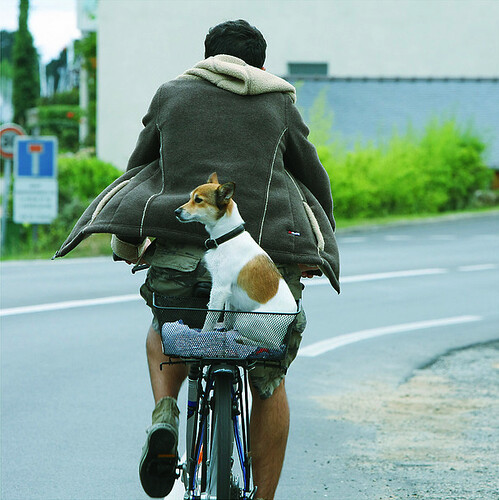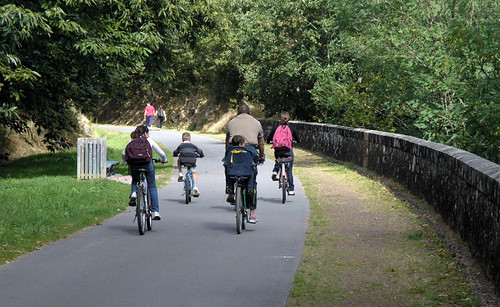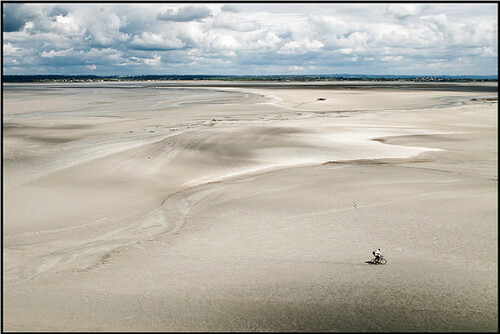Cycling in Brittany is a real treat, with miles of scenic coastal roads and plenty of options for inland cycling along canals and green ways, says Harold Mewes.
Brittany is bicycle-friendly for everyone. Photo: Marc oh!
Follow us on Twitter and Facebook
Both cross-channel ferry routes that bring you directly into Brittany are ideal for cyclists; Plymouth/Roscoff and Portsmouth/St-Malo. From Roscoff there is a ‘quiet road’ cycle route starting at the exit from the port area, initially down a track alongside the railway; and at St-Malo you don't need to leave the port area to find the boat service across the mouth of the River Rance to Dinard, and embark on the system of green ways – level cycle routes on former railways and canal towpaths, free of motor traffic, giving access to nearly all parts of Brittany. The present-day rail system, which positively encourages use by cyclists, has terminus stations at both Roscoff and St-Malo.
One of the first things you notice about Brittany, especially if you arrive at its western end, is how light the traffic is. This is where Brittany really scores because with a density of population less than a third of England’s, there's plenty of scope for free ranging without the feeling that you’re getting in anyone’s way. There are vast areas of countryside to explore, much of it very beautiful, and some of it quite wild.
When to plan a cycling holiday in Brittany
The best months for cycling are usually May and June. The peak holiday months of July and August have in recent years been a bit indifferent weather-wise, but September can be sunny and even October has clear bright days, though getting colder and earth tracks are by then getting a bit muddy.
A family cycling in the Morbihan area of Brittany. Photo: quelquepartsurlaterre
Where to cycle in Brittany
Brittany has a sort of love affair with cycling. The Tour de France frequently passes through and motorists are surprisingly tolerant of the packs of club cyclists that take to the roads at weekends and public holidays. Indeed cycling is one of the most popular sports in Brittany, both on and off road. It is also now recognised as an important contributor to tourism.
The cities of Rennes (Velo Star – in French) and Vannes (Vélocéa – in French) have public bike hire schemes, but you do need to register in advance and pay a deposit. Brest is a bit of a nightmare generally for getting around, so not the place for a leisurely sight-seeing tour on two wheels; the small congested centre of St-Brieuc is better seen on foot. Quimper is currently improving its provision for cycling.
Brittany’s tourist bodies have been working hard to promote cycle touring and this has resulted in the upgrading of hundreds of kilometres of former railway lines and canal towpaths into green ways, open to everyone from wheelchair users to roller-bladers, but most suitable for cyclists. Many signed circuits for day or half-day rides have been developed by local authorities, and centres for mountain-biking (Stations VTT) are run by local affiliates of the Fédération Francaise de Cyclisme (in French).
Long distance cycle touring in Brittany is not only possible, it can be done largely off-road. You could easily occupy a couple of weeks along the 365 kilometres of the Nantes Brest Canal, cycling beside quiet waters with no motor traffic other than the occasional car or van that has permitted access to the lock cottages (see The Nantes-Brest Canal guide from Red Dog Books).
For a mix of canal and old railway track, the green ways offer a network of routes that can take you from the city of Rennes to the heights of the Monts d'Arrée. Particularly scenic are the V7 from Morlaix to Carhaix and the V3 from Malestroit to Questembert. To the north the V3 also takes you to the medieval walled town of Dinan, 30km south of St-Malo. See this suggested self-guided ride from Rennes to Dinan and St Malo, which one of our readers sent us.
There are also many signed circuits for day or half-day rides, mostly in connection with mountain-biking (VTT). Because French cycling is a highly organised national sport, you get the same grading of VTT circuits (green, blue, red and black) as in the rest of France. Mountain-biking sites have been set up in conjunction with tourist offices and local authorities throughout Brittany, and the list is growing: for a useful map of their locations see the Randobreizh site (in French).
Some areas have non-VTT rides geared more to family outings: here the grading of difficulty, colour coding if any, and signing of the route can take on a more localised aspect according to the authority that set it up, usually the département. But even mountain-bike circuits can be followed on a hybrid (VTC – vélo tout chemin) or touring bike, and if the going gets too tough – either for you or your mount – then you can get off and discover the other great outdoor activity: walking.
Getting to Brittany
Brittany is one of France's most accessible regions, thanks to its ferry ports and train network. Brittany Ferries in particular operates an extensive timetable of services year-round from several ports. DFDS Seaways, MyFerryLink, P&O Ferries and Condor Ferries all also run services to Brittany and other northern French ports that provide good access routes. Celticlink Ferries and Irish Ferries both run services from Ireland to the north of France. For information on trains, including the Eurotunnel and Eurostar services to northern France, see our getting to France by train page.
Cycling accommodation in Brittany
It's advisable to book your accommodation in advance, especially in July and August. Many B&B or chambre d'hôtes are run by English speakers and these can often be found on the internet – try Brittany Walks for links and also our own Where to stay section. Zoom into our interactive map to find cycling accommodation on your route.
Planning and support
If you have the time and a lot of patience and some knowledge of French, you can find enough information for some rudimentary planning on the internet. For example, information about bicycle hire shops near railway stations can be found on the SNCF interactive map. Randobreizh has a useful interactive map , from which you can access information on all types of accommodation along the main cycling routes (green ways), and it will tell you which accommodation provides special facilities for cyclists.
If when you arrive in Brittany you find you are short of any equipment or clothing, ask to be directed to the nearest Decathlon - it's a chain of sports equipment stores, usually located on out-of-town retail parks, and has all the basics to get you on the road. Cycle repair shops are plentiful in Brittany, but they are best found by asking the local tourist office. The same applies to bicycle hire; many campsites and accommodation providers offer bicycle hire, as do some tourist offices, eg Morlaix (mostly in French) even has a special cycling centre where you can hire bikes and get all the local VTT routes etc.
In fact real tourist offices with real people behind the counter do a better job of providing information than French websites (tourist office websites included), which are generally ill thought out, short on factual information, frustratingly inefficient, with little or no English, and often out of date. If you need information fast, it's best to phone the relevant tourist office and keep asking questions until you have all the information you could possibly need. (Emails in France usually get answered slowly, if at all, and with as little information as politely possible.) Or you could just get a copy of Brittany's Green Ways: A Guide to Re-Used Railway Tracks and Canal Towpaths (UK, US, Fr) - it covers enough ground to keep you occupied long enough for the average holiday and includes accommodation listings. See the Footprint guide to Brittany (US) for a more detailed regional overview.
The Bay of Mont St-Michel, on the border of Brittany and Normandy.
Photo: Jean-Christophe Dichant
Organised cycling holidays in Brittany
If you want to leave all the planning to someone else, there are cycle touring companies in Brittany that organise complete cycling holidays. Search our Organised tours section for a range of options. The Brittany Ferries website also has useful route suggestions.
Brittany books and maps
Brittany's Green Ways: A Guide to Re-Used Railway Tracks and Canal Towpaths (UK, US, Fr) and The Nantes-Brest Canal (UK, US, Fr), both guides for cyclists and walkers, are excellent.
German publisher Esterbauer Verlag has a cycling atlas that covers the coast of Brittany from Mont-St-Michel to St Pol-de-Léon. There are also two north-south routes from St Brieuc. Text and route notes are in German but the maps and map legends are in English and can be easily followed. French publisher Rando Editions has a guidebook, Le tour de la Bretagne à vélo, in French.
See the Footprint guide to Brittany (US) for a general tourist overview; Footprint also has a new Brittany With Kids (UK, US) guide for families, while Lonely Planet has a Brittany and Normandy book.
Michelin has a regional Brittany map (UK, US), as well as a green guide to Brittany (UK, US). IGN also has a regional map of Brittany (UK, US). In the UK, Stanfords bookshop has an excellent range of Brittany books and maps, including hundreds of IGN maps.
More information on cycling in Brittany
For information on getting to Brittany and other general tourist advice, see our regional guide to Brittany.
See also our guides to cycling the Nantes-Brest Canal, as well as our history of the Nantes-Brest Canal. We also have an overview of St-Malo for cyclists using the Portsmouth ferry link, as well as overviews of Brest, Vannes, Rennes, Quimper, Cancale and the Bay of Mont St-Michel.





